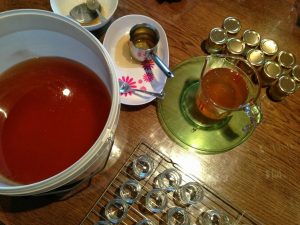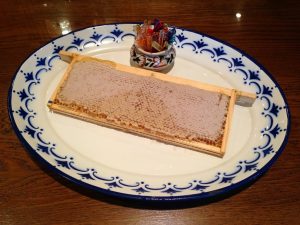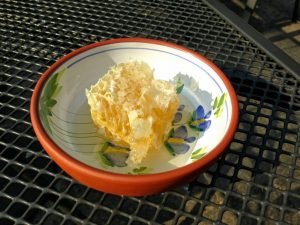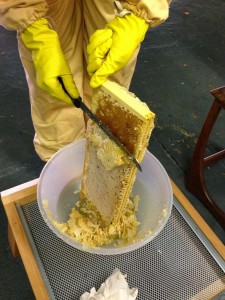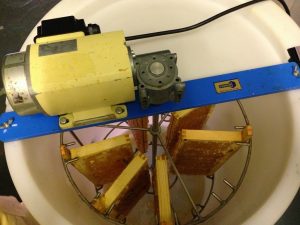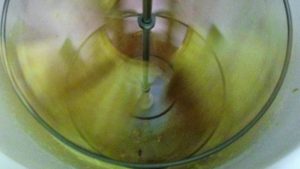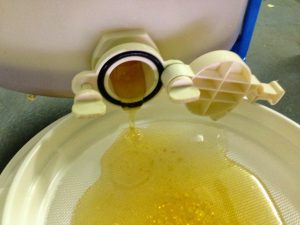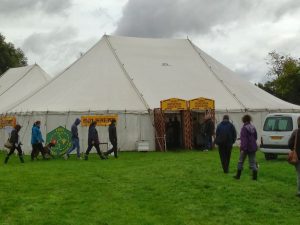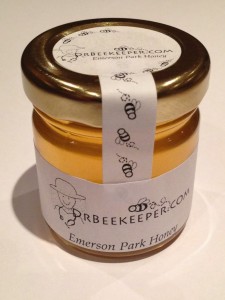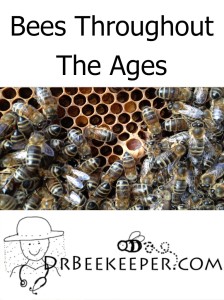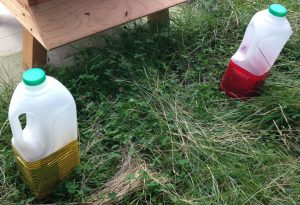It’s been really hectic for the last few months – had it’s highs and lows. Starting with the loss of my first colony, then wedding, close bereavement, and finally getting a brand new colony! I’m sorry to all my followers who have been waiting for updates. I’m back now and ready again to share with you my passion for beekeeping. I’ll let you know what happened to my first colony, how I discovered it hadn’t survived and what steps to take in that situation. Over the next few months, I’ll also be releasing an exciting new series: Dr Beekeeper’s Superfoods. It’s a great comfort to know that in difficult and hectic times beekeeping provides the space for patience and solace. As always, I enjoy hearing from you so please do join me on twitter or leave a post here and I’ll get back to you.
Author: DrBeekeeper
Hapbee New Year from DrBeekeeper!
The wonders of a wet towel in warding off robbing bees
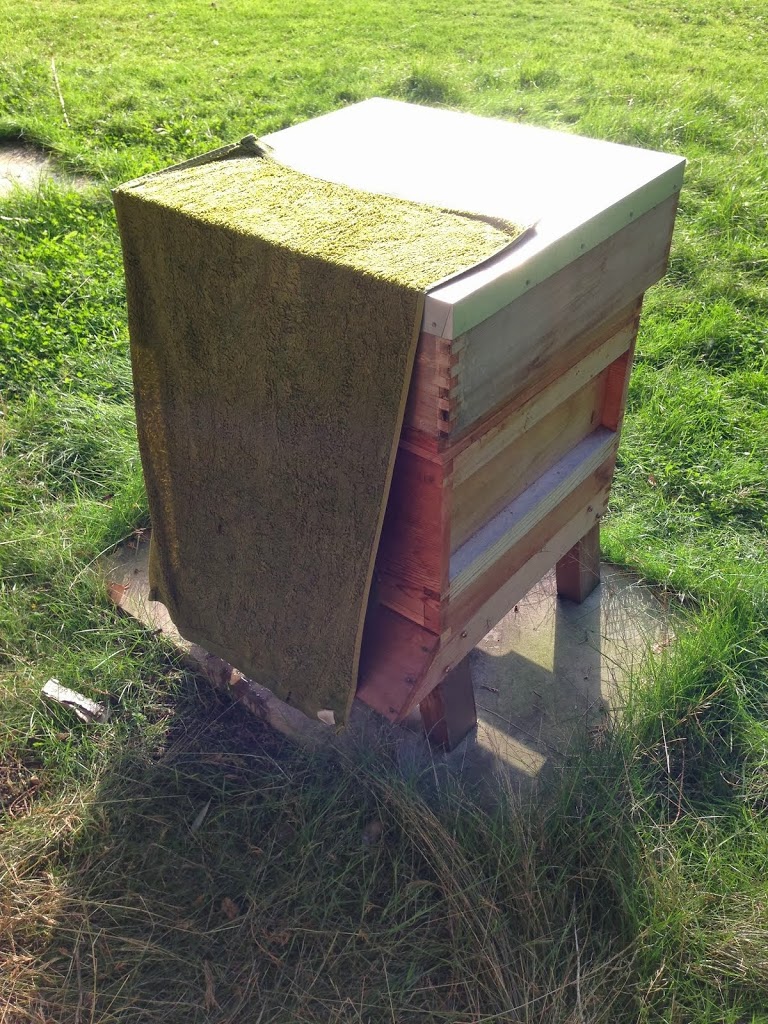
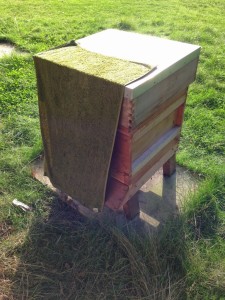 |
| An effective strategy against robbing bees |
In early autumn, as I observed the hive entrance, I noticed something was wrong as there appeared to be large bees at the hive entrance literally attacking my bees trying to gain access to the hive. I quickly established that these were robbing bees who were stealing honey from my hive.
 |
| Home made hive entrance reducer |
To deal with this problem, I started by reducing the hive entrance size using my home made entrance reducer produced simply from a piece of cardboard and some tape. This definitely helped, but it didn’t completely stop the robbing bees.
So I did some research into robbing bees and came across the most bizarre idea – using a wet towel!
Here’s how it worked… I simply soaked a small towel in water and rested one end on the hive roof so that it draped down the entrance leaving a small space between the towel and the hive front.
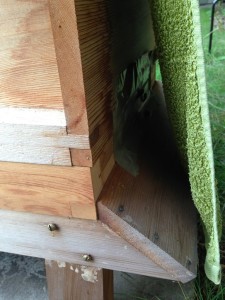 |
At this time, with the abundance of fruit around the garden, I noticed there were wasps hovering around the hive. However, to my surprise, not a single wasp attempted to gain access to the hive via the new open sides (between the towel and hive front). I think this simple idea might be an effective strategy not only for robbing bees but also another tool in the battle against wasps.
Extracting honey doesn’t have to be taxing!
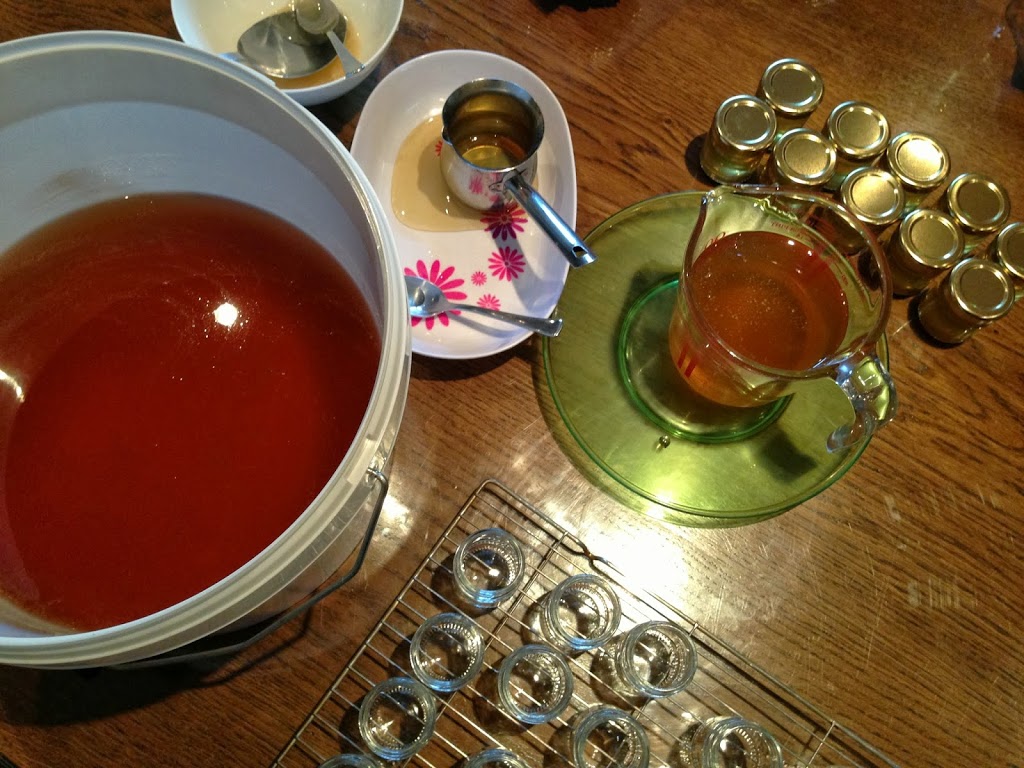
1. Getting ready for honey extraction
What you need:
- Jars – you can estimate 30lb of honey for each full super to work out how many you need.
- Porter bee escapes – 2 for each hive
- Honey bucket – to collect the honey
- Knife – to uncap the capped honey cells
- Honey extractor (although you can harvest without an extractor)
- Bee brush – helpful but not essential (the horse hair one is gentler on the bees than the plastic version)
2. Harvesting honey
Harvesting without a honey extractor
Honey extractors are very expensive and it may not always be possible to get access to one from your local association. Fortunately, even without a honey extractor, harvesting couldn’t be easier.
Option 1: you simply take off a frame of sealed honey and serve directly from the frame! This is great if you’re sharing with others.
Option 2: You can also take a frame and cut the comb into squares which can be put into plastic containers.
The advantage of both of these methods is that you retain the wax which has it’s own taste and health benefits.
Option 3: Use a muslin sheet and placed the honey comb in the sheet. Then squeeze the honey out into jars. This allows you to separate the honey from the wax.
Harvesting with a honey extractor
- Start by removing the supers which area ready i.e. are full of honey cells which are capped.
- Over a bucket and using a bread knife slice off the top layer wax capping (this is called uncapping) so that you reveal hundreds of open honey cells.
- Place the uncapped supers into the extractor ensuring that they are placed opposite each other to balance the weight.
- Start the extractor machine, which spins the supers like a centrifuge releasing the honey from the uncapped cells into the storage bucket.
- Once a good volume of honey has been extracted, open the tap at the front of the hive and release the honey into a honey sieve (2 sieves placed on top of each other with the coarse sieve above the finer one) placed above a honey bucket.
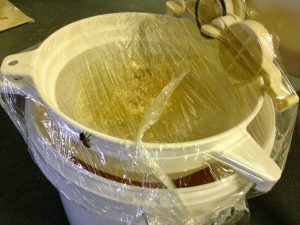
Its worth putting a cling film cover over the sieve at this stage to stop stray bees or wasps feeding on your honey - Allow the honey to settle for a couple of days.
- The honey is now ready to be placed in jars.
3. Jarring honey
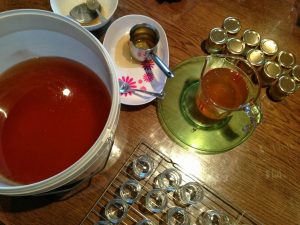 Buy honey jars through your local association to benefit from bulk buying and save on postage costs. It’s best to rinse the jars in warm water or place in a dishwasher to make sure they are completely clean. The washed jars are then placed in a tray and heated at 100C for 5-10 minutes to ensure that every last drop of water has evaporated. While they are being heated clean the inside of the lids with a damp cloth. Remove the heated jars from the oven and allow to cool before pouring the honey into each jar using a measuring jug. Ensure you close the lids tightly.
Buy honey jars through your local association to benefit from bulk buying and save on postage costs. It’s best to rinse the jars in warm water or place in a dishwasher to make sure they are completely clean. The washed jars are then placed in a tray and heated at 100C for 5-10 minutes to ensure that every last drop of water has evaporated. While they are being heated clean the inside of the lids with a damp cloth. Remove the heated jars from the oven and allow to cool before pouring the honey into each jar using a measuring jug. Ensure you close the lids tightly.
You can buy professionally made labels, but these are very expensive so if you can it’s worth making your own. The best thing it to buy some labels of the required size which you can put through your printer (ideally laser printer so the ink is waterproof). There are certain legal requirements for honey labels if you plan to sell – you need to include these details:
- Include the word ‘honey’ which can be prefixed with the type of honey or it’s origin. eg. Essex Honey.
- Weight in metric with figures at least 4mm high for 454g and 227g weights. Imperial weights can also be shown in close proximity to the metric but must be less prominent.
- Your name and address.
- The country of origin eg. Produce of UK. This must be in addition to your address.
- Best before date (usually 2-5 years). If the full date (day, month, year) given a lot number is not needed. Otherwise this must be added.
- Give to family and friends.
- Sell it in local shops (eg farm shops or country parks) and at honey shows.
- Enjoy the taste yourself!
Reflections from my first year of beekeeping with a taste of real honey…

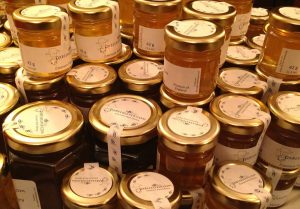 |
| DrBeekeeper Honey |
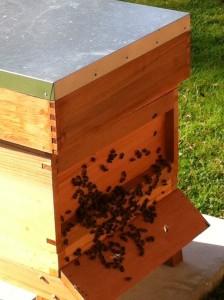
What better way to mark the end of the first year of beekeeping than harvesting your own honey. It’s been an eventful year since my bees arrived after being collected from the swarm on a tree at my beekeeping course in August 2012. Shortly after this I met my queen for the first time. Optimistically, I bought 246 jars of honey in September, even before there was any sign of honey, in the hope of a bumper harvest! In the early period I had problems with ants, which I discovered hate cinnamon, as well as my Ashforth feeder and also learnt how to mouseproof a hive.
In December 2012, I launched a new series of articles I wrote about Bees Throughout History which was published monthly in the British Beekeepers Association newsletter. This series explored the history of bees from their early origins, to their importance in ancient Egypt, Greece, and Rome. It also explored the prominence of bees in religion and finished with an article about bees in the modern world.
More recently, I’ve shared with you a fascinating video of one of my bees hatching as well as my experience visiting a Sicilian apiary. I’ve also written about my experience of dealing with lots of queen cells and my strategy for dealing with wasps.
If you want to find out more about bees and how to get started do explore the site which I created to share my fascination of the complexity of bee society with others. There are also sections about beekeeping for experienced beekeepers as well honey recipes and sources of great honey worldwide. For those taking the BBKA exams you can access the revision guide. I’ve also reviewed several beekeeping sites and books. If you want to connect with other beekeepers you can join Bee Pals – the bee mentor-mentee network. You can also download resources, like inspection records, to help with your beekeeping and follow the calendar of beekeeping events worldwide. Finally, please contribute to the forum and have a look at the honey and gift store.
I hope you’ve enjoyed following the blog this year and welcome your feedback!
The Battle of Wasps attacking Bees. Here’s how my bees are winning…

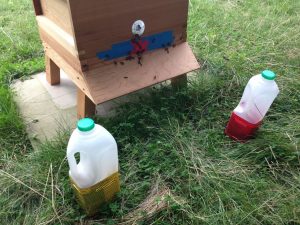 |
| DrBeekeeper’s two pronged strategy for protecting a bee colony from wasp attack |
A few weeks ago I noticed a few wasps roaming around my new hive and thought nothing of it until I soon found the wasps were actually entering my hive through the entrance. The colony was small so the guard bees at the entrance were not strong enough to resist the wasps attacking bees. I ignored this for a while, hoping it would sort itself out, only to find a few days later a major battle occurring between the bees and wasps at the hive entrance.
Observing the hive entrance at this time was like looking at a warfield. The wasps were ferocious, literally flying at bees near the hive entrance, lifting them into the air and depositing them in the ground in front of hive. At times, they would simply walk into the hive with no resistance from the bees whatsoever. During this time, I had read about how wasps can actually dismember bees and destroy colonies. I had worked hard to make this new colony – I couldn’t bear to allow the wasps to kill my bees!
So I developed a two pronged strategy using trial and error to tackle these two key problems:
- The hive entrance is too wide for bees to defend
- There are too many wasps roaming around the hive
PROBLEM 1: The hive entrance is too wide for bees to defend
SOLUTION 1:
Restrict the entrance size with any sort of barrier. For cost saving, I simply used some strong duck tape and applied this on both sides of the entrance leaving a 1cm width gap in the centre to allow bees in an out (Experiment 1).
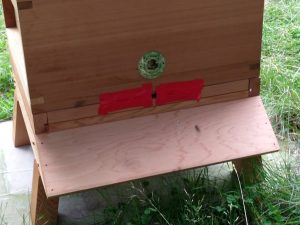 |
| Experiment 1 |
However, although less wasps were entering, there were still significant numbers gaining entry to the hive. So I then tried completely occluding the hive entrance with duck tape leaving a 6mm diameter hole (Experiment 2). Although this allowed bees in and out, I noticed that the single bee entry actually made it hard for the guard bees to defend the hive when a wasp chose to enter.
 |
| Experiment 2 |
During this time I read that wasps don’t like to enter tubes so I filled the 6mm hole with a short cutting of a straw (Experiment 3). This was hugely successful at ensuring no wasps entered the hive, but also had the undesired effect of stopping bees entering and leaving too!
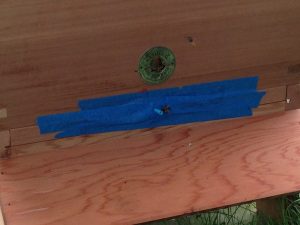 |
| Experiment 3 |
Finally, I came up with the final solution which really works. As before, the hive entrance was occluded with duck tape, leaving a 6mm diameter hole in the centre. Immediately in front of this hole, the metal cylindrical part of a garden hose tap connecter was placed and attached with duck tape. This worked because it allows bees into and out of the hive whilst also allowing sufficient space within the metal cylinder to allow the bees to defend themselves against attack.
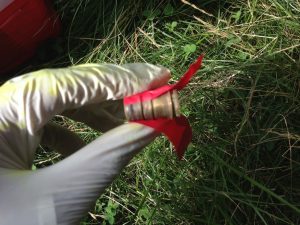 |
| Garden hose tap connector |
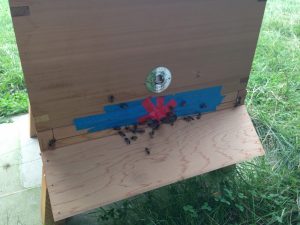 |
| The final solution |
PROBLEM 2: Too many wasps roaming around the hive
SOLUTION 2:
I decided to create a wasp trap to help reduce the numbers of wasps and therefore reduce the risk of them attacking the colony. The shop bought ones were expensive and I had read didn’t work very well. So I made my own which only takes 5 minutes and here’s how…
- Milk bottle (plastic and empty with lid in place)
- Scissors
- Ruler
- Nail or sharp object
- Opaque/dark-coloured duck tape
- Old fruit jam/juice or anything wasps like
- Apply tape to the lower half of the milk bottle (to prevent light from entering).
- 1 cm below the upper rim of the taped area, on all four sides, create flaps of approximately 4-6cm in width and 1cm in height (depending on the size of your bottle, these will be the entry points for the wasps).
- At the top of the milk bottle, around the lid create holes using a nail or sharp object (which will allow the smells of the trap contents to attract wasps).
- Fill the milk bottle to a level approximately 2 cm below the cut flaps with any substance which attracts wasps eg. rotten fruit, fruit juices, a few spoons of jam (note bees are not attracted to this disgusting mixture!).
- Finally, place the wasp trap in front of the hive or near the area where wasps are congregating.
- Every few days clear out the trap which will contain lots of wasps but should not contain any bees
Too many queen cells? How to split the colony to prevent swarming…

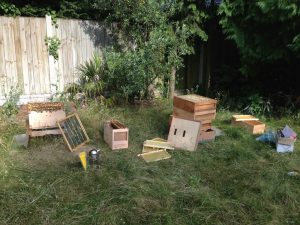 |
| Things got chaotic when I discovered lots of queen cells in the hive |
After returning from holiday, I inspected the hive and couldn’t believe how many queen cells there were. Something was clearly wrong, so I called me bee mentor who explained this could be a sign that the bees were preparing to swarm.
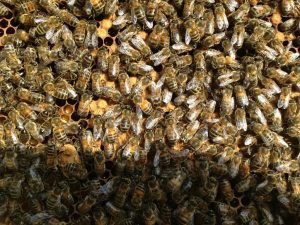 |
| Sealed queen cell |
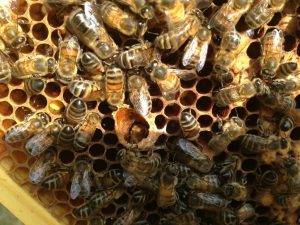 |
| Open queen cell from hatched queen |
I was advised to split the hive so this is what I did…
Splitting an existing hive with no queen into two hives with queens
- I inspected every frame on the existing hive and located the best looking queen cells.
- I set up a new empty nucleus hive a few metres next to the existing hive.
- From the existing hive, I transferred one brood frame with a good queen cell (you could see the larva inside as it hadn’t been sealed yet) into the nucleus hive. On the frame that I transferred I destroyed all the other queen cells.
- So the nucleus hive now contained one frame with the queen cell. From the existing hive I also transferred a frame of stores and a frame of brood which I placed either side of the queen frame. A dummy board was inserted.
- Then I shook bees from a single frame from the existing hive into the nucleus hive to increase the population of the new colony (before returning the shook frame to the existing hive).
- The nucleus hive was then closed and the front entrance stuffed with some grass.
 |
| Some grass stuffed into the entrance of the new nucleus hive |
- In the existing hive, I destroyed all the queen cells except 2 which were sealed (if I could see the larva at the unsealed stage I would have just kept one).
2-3 days later…
 |
| A branch was deliberately placed in front of the hive to force the bees to take an orientation flight |
- I placed a branch in front of the nucleus hive entrance so that when the entrance grass was removed, the bees saw a new environment which forced them to take an orientation flight (preventing them from returning to the existing hive).
- I inspected both hives and could see that in the existing hive the 2 queen cells had both hatched (so the colony would have to select 1 queen which would subsequently go on a mating flight). In the nucleus hive, the previously unsealed queen cell was now sealed so was developing as expected.
- The nucleus hive was opened and the queen had successfully mated as there were new larvae.
- The existing hive was also checked and there were lots of eggs cells and also a sighting of the queen bee confirming successful mating.
- The frames from the nucleus hive were removed and inserted into a new hive at the same site. A contact feeder was placed on the new hive to help build up the colony.
World Honey: A trip to a Sicilian Farm
| Bergi’s Apiary in Castelbuono (Sicily). See the new World Honey page for more details! |
 |
| A pile of multi-coloured supers and a honey extractor |
| The wires are framed very differently to the standard British frames |
| The farm’s honey bottling room |
The honey tastes incredible, it’s quite strong and flavoursome – definitely worth a try. They come in a range of flavours including Asphodelian (a Eurasian plant from the lily family), Orange blossom, and Mixed flowers.
| Honey fresh from the farm – tastes amazing! |
| A range of different honeys from hives around Sicily |
Saw a bee hatching in my hive…here’s the video!
Just saw the most incredible thing as I was looking at the frames I could see the head of a bee just popping out of the cell. On my video above you can see it struggling to hatch and after a minute or so it finally emerges into freedom. The surrounding worker bees and drones seem completely oblivious to her birth! Reminds me of my time as a medical student assisting the midwifes with births; although the equivalent process took several hours.
Hive inspection update: the bees are making lots of honey, one super feels almost full and they look like they’re about to start filling the second super on top. There might actually be enough honey to fill the jars I bought.
| Several super frames seen from above which are full of honey! |
 |
| You can see the bees have started sealing the honey at the top middle of the super frame. |
If you’ve got any interesting photos or videos please send them and I’ll share them here…
Bees Throughout The Ages: Bees in the Modern World
17 and 18th century
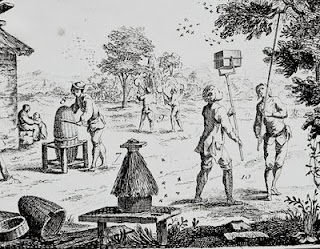 |
Beekeeping in 1772 as illustrated in L’Encyclopédie ou Dictionaire Raisonné Des Sciences et Arts et des Métiers (a major French encylopaedia of the 18th century |
19th century
 |
Lorenzo Langstroth (1810-1895) |
 |
Early design of a honey extractor |


